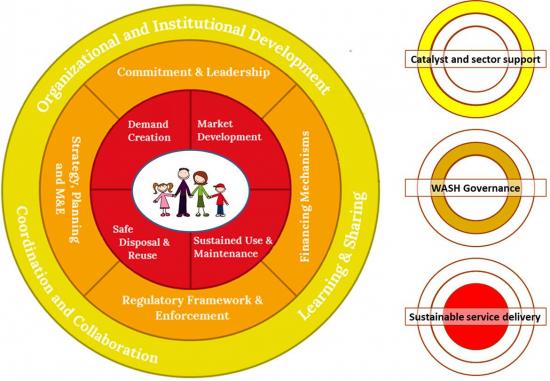Here’s a real life riddle: there is a huge problem that has not been solved yet. Many options tried so far only dealt partially with the problem and ironically, you are the one asked to solve the whole problem. You know that everything is important; you know you have to include all parts of the problem; and you estimate that tackling everything in a proper and long-lasting way will take at least 10 years. You know this is a no-go: you are asked to come up with something to start next month. What will you do?
Published on: 22/09/2015
So what is this problem that we have to solve: well, it is called sanitation. Still 2.6 billion people in the world do not have a proper toilet. IRC challenged sector players at the IRC debate event on 9 September 2015 to look at urban sanitation from a whole system approach and to come up with practical steps to implement it.
Ensuring safe sanitation facilities for everyone, everywhere and all the time, is a simple phrase. To make this actually happen, we have to look at the whole system in which sanitation service delivery takes place: all the elements of the sanitation chain need to be looked at: from containment and transport, to treatment and safe disposal and re-use. And even this will not be successful if the operational side is not backed by well-functioning institutions. If all stakeholders dealing with sanitation service delivery continue with business as usual, nothing will change.

All institutions, organisations, private sector and customers need to be involved in the planning process from the start and all have their own roles and responsibilities. It means that government needs to be in the lead for effective collaboration, harmonisation and alignment, not necessarily doing the work themselves. It also means that services are monitored for continuous improvement, and that sustainability is taking into account from the start: financial, institutional, environmental, technological and social sustainability.
It all starts with knowing where the biggest – or most risky - problems lie. Some first very rough assessments, preferably in simple graphics, should be made and discussed with the different stakeholders. More detailed assessments on who, why, where, related to the identified key issues are needed as well, but considering the urgency of the problem, it is important to get the process started as soon as possible. As Almud Weitz, principal lead of Asia WSP World Bank team, said at the International Faecal Sludge Management conference in Hanoi in January 2015: “faecal sludge is drowning us, that’s an image that may encourage us to take this issue seriously!”
The majority of the urban population already live on a huge waste dump, as only a small percentage of all the human waste actually ends up safely in the environment. The shit flow diagram exercise presents us with a good visual illustration.
To start thinking from a whole system change perspective requires a change of mind-set of all actors involved – including ourselves! To demonstrate how this can be done, IRC, GIZ, EAWAG invited sector players to a workshop held at the International Faecal Sludge Management conference in Hanoi.At this, workshop participants were presented with an experience which can lead to a different mind-set. The participants were divided in four groups: users, public service authority, private sector, and the utility or service provider. Each of the groups looked at key issues in the sanitation chain from their point of view.
Interestingly, not only different, but even conflicting interests were expressed, and some of the sustainability issues around environment and social sustainability got hardly any attention. This reflects our experience with stakeholder group meetings in the real world, which show that technological aspects are often the starting point while financial and environmental dimensions get less attention.
IRC’s approach that looks at the whole system and involves all stakeholders is not unique as was shown by Jan Spit of WASTE and Bas van Vliet from Wageningen University at the IRC debate event on 9 September. IRC presented the whole system change approach for sanitation and WASTE presented their Diamond model. Wageningen University conducted a study called “modernised mixtures”. Presenting the study, Dr Bas van Vliet noted that: "it’s about creating a fit between options for infrastructures and socio-economic, technological, political and ecological conditions."
Earlier this year our colleague Giacomo Galli wrote a briefing note which proposes a process for achieving transformational change. There are many tools available in the sector and they demonstrate the immense potential of joined collaboration and partnerships for change in the sector. So it is all out there and there is no time to waste, get out from behind your desk and act.
At IRC we have strong opinions and we value honest and frank discussion, so you won't be surprised to hear that not all the opinions on this site represent our official policy.